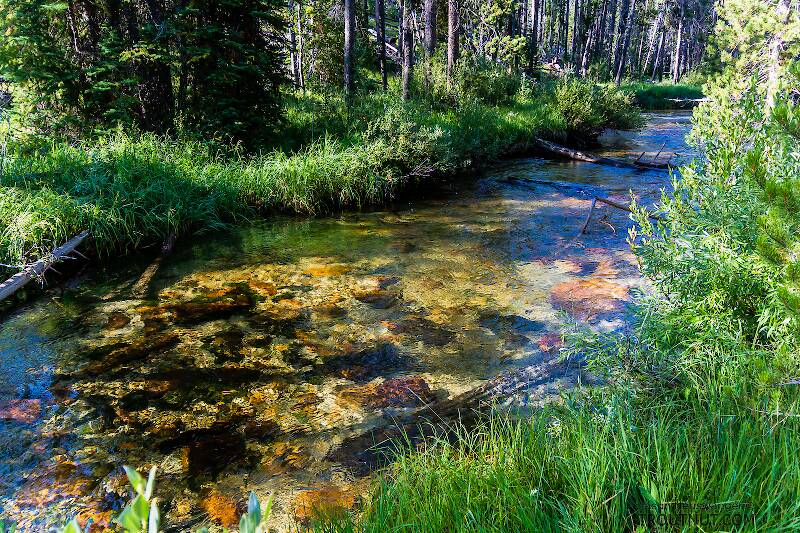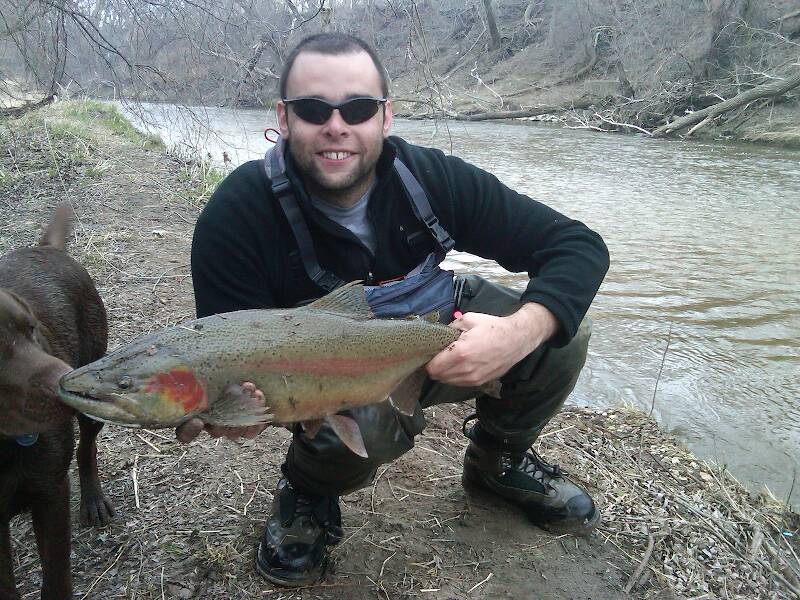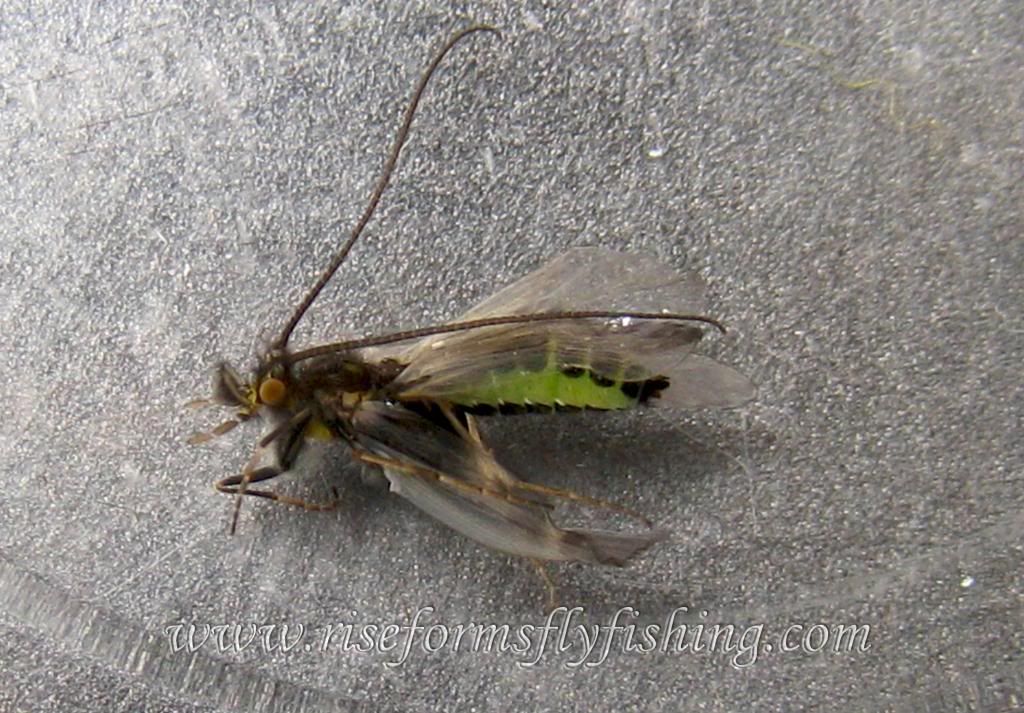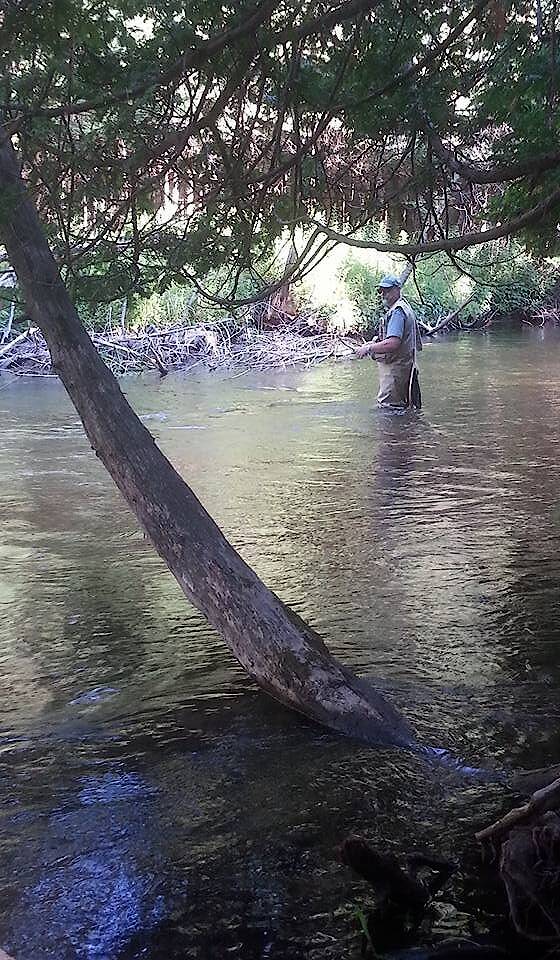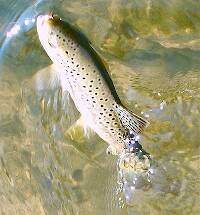
Salmonflies
Pteronarcys californica
The giant Salmonflies of the Western mountains are legendary for their proclivity to elicit consistent dry-fly action and ferocious strikes.
Featured on the forum

This seems to be a young larva of Limnephilus. Although not clear in the picture, several ventral abdominal segments have chloride epithelia.

Troutnut is a project started in 2003 by salmonid ecologist Jason "Troutnut" Neuswanger to help anglers and
fly tyers unabashedly embrace the entomological side of the sport. Learn more about Troutnut or
support the project for an enhanced experience here.
PaulRoberts on Mar 30, 2015March 30th, 2015, 9:13 pm EDT
Hi Paul,
Thanks for the kind words about my ties. I live under a rock, in a cave, and have not the slightest clue who Bob Wyatt is. Is he an author of fly fishing books?
Thanks for sharing them. It's always neat to see what's in an accomplished anglers working box.
Well I too have been living in a cave of late -a very tall one- and I hadn't heard of Bob Wyatt until Spence mentioned him and I looked him up. He's a FF guide and writer from down under with strong opinions on trout feeding behavior. My mentions of him were for Spence's benefit. Spence seems to feel that some people (whom he may be baiting) are uneasy with Wyatt's take on selectivity and the need for replica-quality trout flies. I happen to think Wyatt's observations are quite astute and are backed by some science. I'm kinda wondering when all hell is going to break loose from the mere mention of Wyatt's name.
Entoman on Mar 31, 2015March 31st, 2015, 4:02 am EDT
I've had great fishing with Caddis dries in the right circumstances, usually predicated on observing the bug behavior that almost always drives fish behavior. Downstream from blanket hatches usually produces the best. Picking off spent caddis and adult stragglers is the easiest so the biggest fish are often there to take advantage. I almost always fish downstream during Caddis frenzies swinging soft hackles and other styles to match both pharates and ovipositors that are often in the water at the same time. Usually ovipositing causes the greatest concentration as the pharates for most species will trickle off far more than most realize. Also, many anglers make the mistake of imitating the short winged pupa that are only free for observation from their little houses in angling literature. Fish don't see these.
"It's not that I find fishing so important, it's just that I find all other endeavors of Man equally unimportant... And not nearly as much fun!" Robert Traver, Anatomy of a Fisherman
Crepuscular on Mar 31, 2015March 31st, 2015, 4:43 am EDT
I've had great fishing with Caddis dries in the right circumstances, usually predicated on observing the bug behavior that almost always drives fish behavior. Downstream from blanket hatches usually produces the best. Picking off spent caddis and adult stragglers is the easiest so the biggest fish are often there to take advantage. I almost always fish downstream during Caddis frenzies swinging soft hackles and other styles to match both pharates and ovipositors that are often in the water at the same time. Usually ovipositing causes the greatest concentration as the pharates for most species will trickle off far more than most realize. Also, many anglers make the mistake of imitating the short winged pupa that are only free for observation from their little houses in angling literature. Fish don't see these.
Hey Kurt! hope you are well. Thanks for chiming in here. You bring up an important fact about the life stages of the caddis that are available to trout. It's not always easy to mimic the behavior of the emerging and ovipositing caddisfly, the downstream presentation certainly helps in presenting a fly in a speedy and sometimes erratic manner that is characteristic of many caddis.
Oldredbarn on Mar 31, 2015March 31st, 2015, 6:48 am EDT
Damn! Nice first thread newbie from PA. :)
I go away last night after posting my reply. My last winter tying session. We tied a couple bugs and found a beer hall, and I return and all hell breaks loose. Got to love it!
Must be getting close. The energy levels getting up there for the inmates on TN. settle down Boys. We'll all be fishing soon.
Spence
I go away last night after posting my reply. My last winter tying session. We tied a couple bugs and found a beer hall, and I return and all hell breaks loose. Got to love it!
Must be getting close. The energy levels getting up there for the inmates on TN. settle down Boys. We'll all be fishing soon.
Spence
"Even when my best efforts fail it's a satisfying challenge, and that, after all, is the essence of fly fishing." -Chauncy Lively
"Envy not the man who lives beside the river, but the man the river flows through." Joseph T Heywood
"Envy not the man who lives beside the river, but the man the river flows through." Joseph T Heywood
Kschaefer3 on Mar 31, 2015March 31st, 2015, 7:11 am EDT
We'll all be fishing soon.
Good thing!
I was fortunate and managed two weeks off, April 11-26, in between jobs. You better believe I'll be out fishing. All this talk of caddis has me excited, and I hope they are out then!
Crepuscular on Mar 31, 2015March 31st, 2015, 7:18 am EDT
MiltRPowell
Posts: 106
Posts: 106
MiltRPowell on Mar 31, 2015March 31st, 2015, 8:32 am EDT
Hell, that's no distraction that bug I been looking for. Any bug, even a blood sucking Tarantula...
Yes, day break, games in play in N.Y. May have to fight off the worm sneaker wearing bank runners & I gotta harvest my limit guys. But I'll be back in the water. Fishing spots they cannot harveat from, the good spots. Tight over grown banks, seen some in there this morn. Hey peaking legal, at least I think it is...
Yes, day break, games in play in N.Y. May have to fight off the worm sneaker wearing bank runners & I gotta harvest my limit guys. But I'll be back in the water. Fishing spots they cannot harveat from, the good spots. Tight over grown banks, seen some in there this morn. Hey peaking legal, at least I think it is...
flyfishingthecreekM.R.P.
Wbranch on Mar 31, 2015March 31st, 2015, 11:39 am EDT
Hello Kurt,
Would you please explain, in more detail, the above comment? Are you saying the trout don't ever see the short winged pupa rising in the water column? Then what are the fish eating during the blanket caddis emergences that I see and am only seeing boils, bulges, and dorsal fins?
Also, many anglers make the mistake of imitating the short winged pupa that are only free for observation from their little houses in angling literature. Fish don't see these.
Would you please explain, in more detail, the above comment? Are you saying the trout don't ever see the short winged pupa rising in the water column? Then what are the fish eating during the blanket caddis emergences that I see and am only seeing boils, bulges, and dorsal fins?
Catskill fly fisher for fifty-five years.
PaulRoberts on Mar 31, 2015March 31st, 2015, 3:20 pm EDT
Downstream from blanket hatches usually produces the best. Picking off spent caddis and adult stragglers is the easiest so the biggest fish are often there to take advantage.
Bingo! (Ach...gotta run)
Hi Kurt!
Entoman on Mar 31, 2015March 31st, 2015, 6:16 pm EDT
Thanks guys, been too busy to post lately but I'm always lurking.:)
Sure, Matt...
As caddis pharates are very difficult to capture, most photos in books (the ones used for models by generations of tiers) show pupa plucked from rocks. Those very short stubby wings held tight to the body are as they appear safe in their shelters, not swimming for their lives to escape the maws of trout. Most pharates have longer flowing wings and appear to be all legs and antennae in motion. They often look like water boatmen when swimming in pulsing motions. A tough nut to crack imitation wise.
A proper approach to fishing caddis hatches needs to take into account the biological differences between them and the more familiar mayflies we normally fashion our approaches after. Unlike mayflies, caddis are much longer lived. This makes for profound differences required tactically. When we see a blanket hatch of mayfly we normally assume similar or even greater activity on the part of nymphs and emergers underneath the surface - and we are normally right in assuming so. Not true with caddis... When we see a blanket hatch of caddis the vast majority are returning adults that have trickled out in waves of emergence over many days and in some cases weeks. The time for pharates is when you see numbers of caddis rising slowly off the water with no real swarms present. At those times I prefer deeply fished dead drift pupa patterns mostly (as the fish rarely show themselves at these times) or go shallower with a pulsing retrieve if the fish start to work up top. This activity will often resemble a sparse but fishable mayfly hatch usually with few fish working up top (but they're very busy underneath). When the caddis are so thick that they fill the air and the fish are going nuts, your best bet is to fish the adults subsurface. I haven't found anything more efficient than soft hackle derivatives for this.
Sure, Matt...
As caddis pharates are very difficult to capture, most photos in books (the ones used for models by generations of tiers) show pupa plucked from rocks. Those very short stubby wings held tight to the body are as they appear safe in their shelters, not swimming for their lives to escape the maws of trout. Most pharates have longer flowing wings and appear to be all legs and antennae in motion. They often look like water boatmen when swimming in pulsing motions. A tough nut to crack imitation wise.
A proper approach to fishing caddis hatches needs to take into account the biological differences between them and the more familiar mayflies we normally fashion our approaches after. Unlike mayflies, caddis are much longer lived. This makes for profound differences required tactically. When we see a blanket hatch of mayfly we normally assume similar or even greater activity on the part of nymphs and emergers underneath the surface - and we are normally right in assuming so. Not true with caddis... When we see a blanket hatch of caddis the vast majority are returning adults that have trickled out in waves of emergence over many days and in some cases weeks. The time for pharates is when you see numbers of caddis rising slowly off the water with no real swarms present. At those times I prefer deeply fished dead drift pupa patterns mostly (as the fish rarely show themselves at these times) or go shallower with a pulsing retrieve if the fish start to work up top. This activity will often resemble a sparse but fishable mayfly hatch usually with few fish working up top (but they're very busy underneath). When the caddis are so thick that they fill the air and the fish are going nuts, your best bet is to fish the adults subsurface. I haven't found anything more efficient than soft hackle derivatives for this.
"It's not that I find fishing so important, it's just that I find all other endeavors of Man equally unimportant... And not nearly as much fun!" Robert Traver, Anatomy of a Fisherman
Entoman on Mar 31, 2015March 31st, 2015, 7:05 pm EDT
Now there's a proper model for designing pharates otherwise (and erroneously) known as "emergent pupa" or even a diving adult.
Great (and rare) photo, Eric!
Great (and rare) photo, Eric!
"It's not that I find fishing so important, it's just that I find all other endeavors of Man equally unimportant... And not nearly as much fun!" Robert Traver, Anatomy of a Fisherman
PaulRoberts on Apr 1, 2015April 1st, 2015, 1:09 am EDT
Thought I'd bring this one back up as it pertains to the visual aspects of caddis activity:
http://www.troutnut.com/topic/2516/Caddis-Pupae-Question
At the end of the thread Ralph Cutter and Gary Borger weigh in.
http://www.troutnut.com/topic/2516/Caddis-Pupae-Question
At the end of the thread Ralph Cutter and Gary Borger weigh in.
Feathers5
Posts: 287
Posts: 287
Feathers5 on Apr 1, 2015April 1st, 2015, 5:46 am EDT
Thought I'd bring this one back up as it pertains to the visual aspects of caddis activity:
http://www.troutnut.com/topic/2516/Caddis-Pupae-Question
At the end of the thread Ralph Cutter and Gary Borger weigh in.
That's a greast article, Paul. I guess I should read what's on our site more often.
Oldredbarn on Apr 1, 2015April 1st, 2015, 11:43 am EDT
Thanks for bringing this back up Paul! Great photo, as usual, Eric!
Spence
Spence
"Even when my best efforts fail it's a satisfying challenge, and that, after all, is the essence of fly fishing." -Chauncy Lively
"Envy not the man who lives beside the river, but the man the river flows through." Joseph T Heywood
"Envy not the man who lives beside the river, but the man the river flows through." Joseph T Heywood
Roguerat on Apr 1, 2015April 1st, 2015, 11:56 am EDT
Would a pattern mimicking the pharate stage of a caddis be a dry or a submerged fly? Are there any patterns in use (wet or dry) for this? That is one neat looking insect, great photography...!
Roguerat
'Less is more...'
Ludwig Mies Vande Rohe
Roguerat
'Less is more...'
Ludwig Mies Vande Rohe
Quick Reply
Related Discussions
Topic
Replies
Last Reply
2
Jul 9, 2018
by Martinlf
by Martinlf

